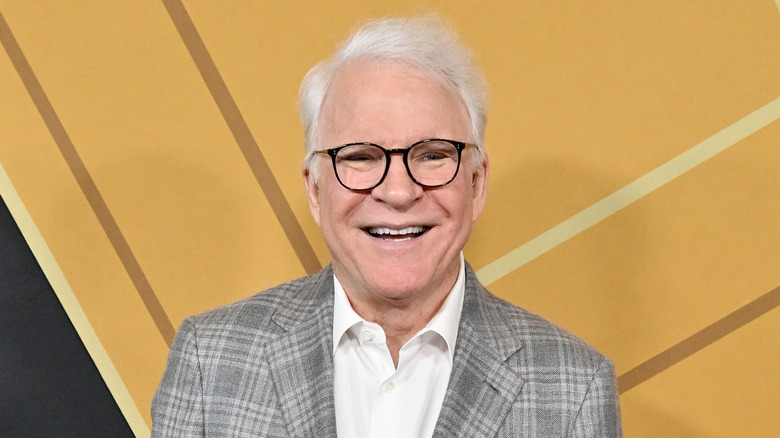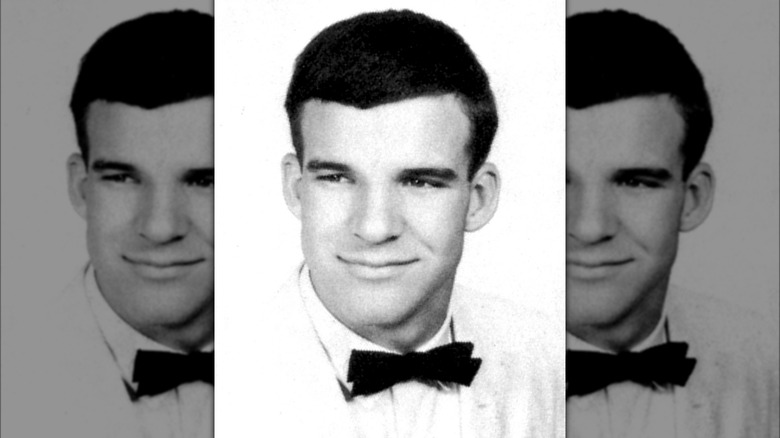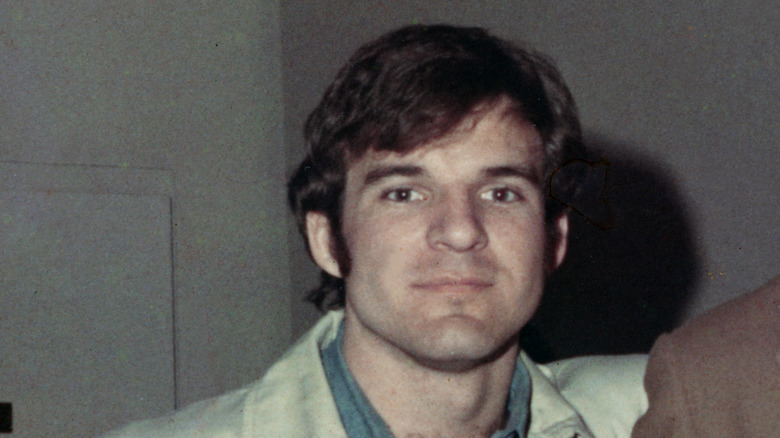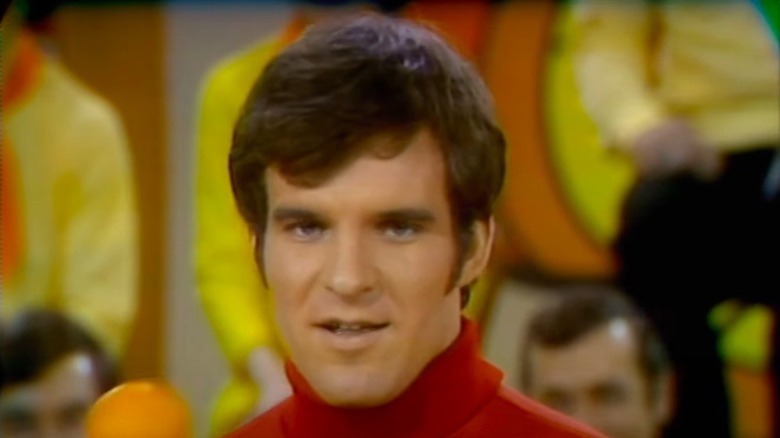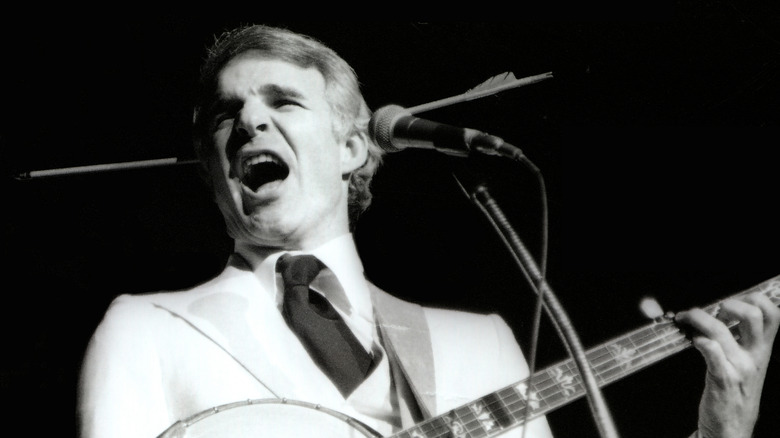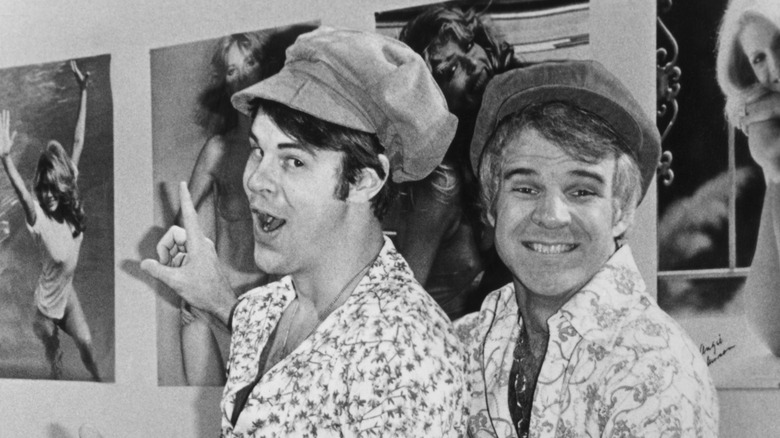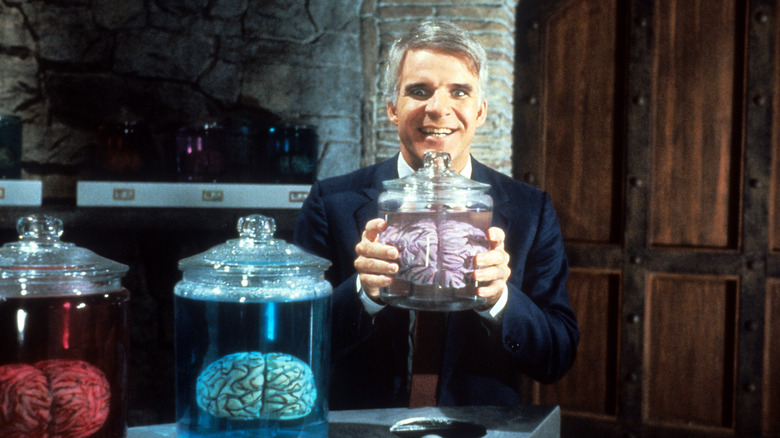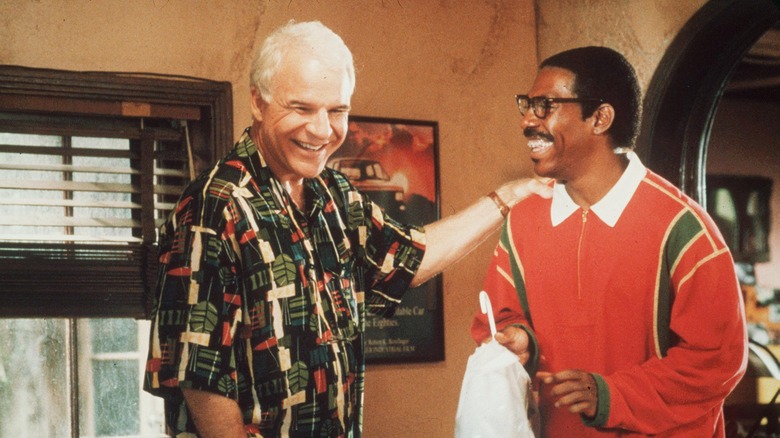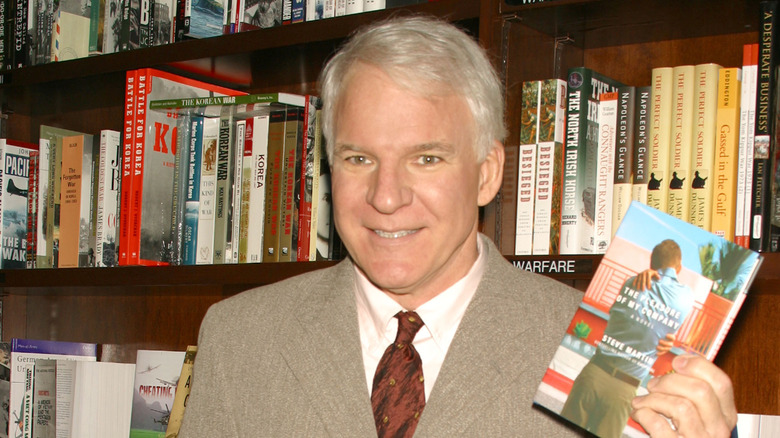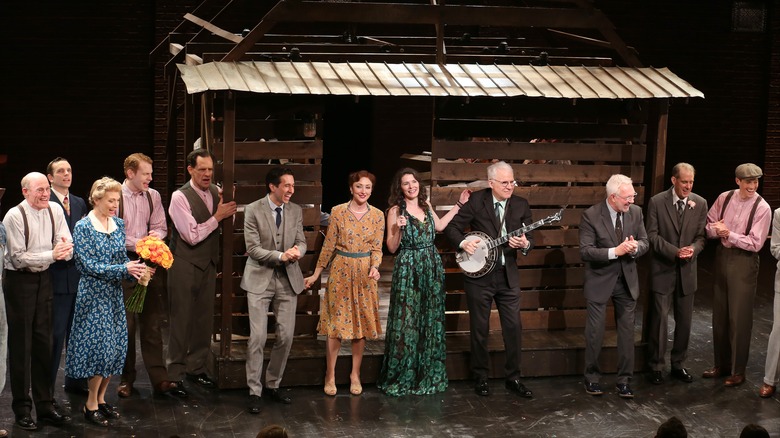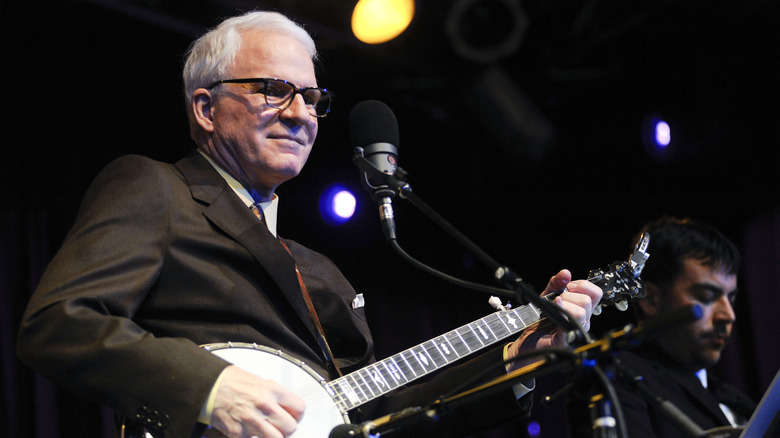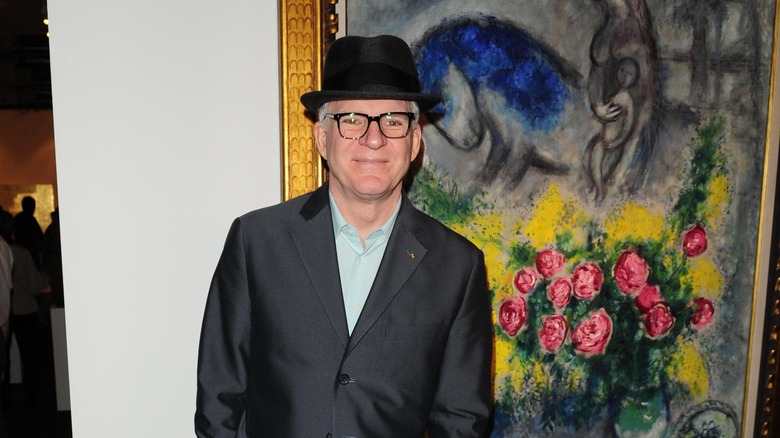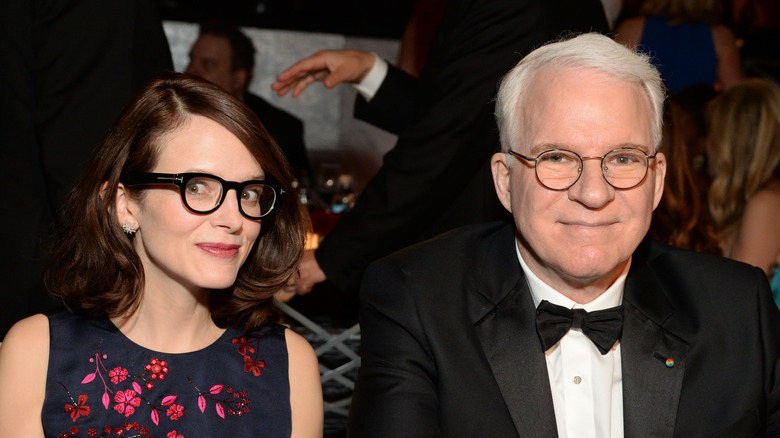The Stunning Transformation Of Steve Martin
In the pantheon of American comedy, Steve Martin is in a league all his own. A recipient of the prestigious Mark Twain Prize for American Humor, Martin's career has been as long and distinguished as it's been eclectic and unpredictable. After years spent honing his act, Martin broke through in the 1970s with an absurdist tone that nailed the zeitgeist. That's reflected in his trio of mega-hit comedy albums — 1977's "Let's Get Small," 1978's "Wild and Crazy Guy," and 1979's "Comedy is Not Pretty" — and exemplified when his hit zany hit single, "King Tut," sold a million copies and made it to No. 17 on Billboard's pop charts. As his punchlines became catchphrases that permeated pop culture ("Well, excuuuuse me!"), Martin was catapulted from dingy nightclubs to performing at the type of venues typically reserved for sporting events and rock concerts.
These days, Martin is an elder statesman of comedy while also gaining a reputation as something of a Renaissance man, whose varied pursuits have included television, movies, novels, stage plays, art criticism, music (as both a performer and composer), and even Broadway productions. Meanwhile, he's demonstrated he still has a few tricks up his sleeve with the critical and commercial success of his Hulu series "Only Murders in the Building," evidenced by the show's 28 Emmy nominations.
It's been a wild (and crazy) ride, and it's not over yet. To find out more, read on to experience the stunning transformation of Steve Martin.
He got his start at Disneyland
Steve Martin was born in 1945 and grew up in California's Orange County, not far from Disneyland. For Martin, the Magic Kingdom wasn't just a theme park; it was his place of employment, where he worked from the age of 10 until he was 18. Initially, he sold guidebooks at the entrance and then graduated to demonstrating souvenir lassos in Frontierland before moving on to Merlin's Magic Shop, performing magic tricks for tourists. "I knew every nook and cranny of the shop," he recalled in an interview for Walt Disney Archives.
In a 1992 interview, Martin recalled the surreal experience of being a child with a job at Disneyland. "I had a good time," he admitted. "I was in a fantasy world. You know, you go to work and you're 10, and you put on the little straw hat ... and you're selling newspapers. It was really fun." Working at the magic shop as a teenager, spending eight-plus hours per day immersed in magic tricks, honed his skills at prestidigitation to a razor's edge. "That experience was so valuable," he said.
When Martin was 18, he landed a gig at nearby Knott's Berry Farm, performing in a stage production that ran four times each day (five on Sundays). After each of those shows, he'd put on his own 10-minute performance that combined magic tricks, banjo music, and comedy — an embryonic version of the act that would later catapult him to superstardom.
Studying philosophy in college changed his comedic perspective
After graduating from high school, Steve Martin enrolled in junior college. It was there he befriended a girl named Stormie, who encouraged him to read Somerset Maugham's novel "The Razor's Edge." "It was all about a person who questions life," Martin recalled in an interview with Newsweek. "I read it and I can remember afterwards sitting in a park and Stormie saying, 'Knowledge is the most important thing there is.' That's when I really decided to go to college."
He gravitated toward philosophy and began studying in earnest. "I went at it totally, 100%, all the way. I'd go in for a test, and it was like I'd done it before I got there. It was a very important time in my life," Martin recalled. As he became increasingly immersed in philosophy, he ultimately concluded that attempting to understand all those schools of philosophical thought was pointless. He transferred to UCLA in 1967 and decided to change his major to theater.
He also began performing in Los Angeles comedy clubs, building upon the act he'd performed at Knott's Berry Farm. His entry into standup comedy, he told Rolling Stone in 1982 (via the book "Conversations with Steve Martin"), was somewhat accidental. "I was figuring out a way to get onstage," Martin explained. "I made up a magic act and, 'Hey, I'm in showbiz,' and that led to nightclubs."
He found early success as a TV comedy writer
At age 21, Steve Martin wasn't exactly setting the world of standup comedy on fire. A lucky break came when a dancer he was dating connected him to Mason Williams, head writer for "The Smothers Brothers Comedy Hour." Williams was impressed enough to give him a job — sort of. "I was hired, but not hired," Martin told The Hollywood Reporter. "I got $300 a week, which was about three times more than I'd ever made in my life. I found out later that Mason was paying me out of his own pocket."
Martin eventually found his groove as a writer, and also managed to appear on the show a few times — in sketches, or showcasing his skills at magic tricks and his juggling. He may have been making a great living writing for one of TV's most popular shows, yet Martin was dissatisfied; he yearned to perform, and decided to quit so he could resume his pursuit of standup comedy.
While he continued to hone his act, Martin's career stagnated. He decided to leave L.A., and wound up in Aspen, Colorado. He made the decision to stop being the opening act for others and only headline his own shows. His income plunged, at least initially, but he slowly began building up a following. "That changed my life," Martin explained during an appearance on "The Howard Stern Show," "because when I started headlining, people started paying attention."
Breaking through in standup comedy
By 1975, Steve Martin was a comedy star on the rise. His act, sharpened by years of performing in tiny clubs, was now being seen by bigger audiences. Meanwhile, he began earning a reputation for wacky stunts, such as the time he invited the entire audience to accompany him to McDonald's, where he ordered 247 burgers — and then changed the order at the last minute to a single order of fries.
Sensing the tenor of the times, Martin realized the political counterculture shtick that ruled comedy in the early part of the decade was wearing thin. That was when he shed the hippie persona he'd adopted, cutting his hair short, shaving off his beard, and donning the white suit that would become his onstage uniform. "Instead of looking like another freak with a crazy act, I now looked like a visitor from the straight world who had gone seriously awry," he wrote in his memoir "Born Standing Up," excerpted by Smithsonian magazine. His act evolved into a dada-esque parody of standup, with Martin portraying an idiotic comedian so bad at comedy that his ineptitude was hilarious. "The act was becoming simultaneously smart and stupid."
In 1976, one of Martin's performances was recorded for the fledgling pay-cable channel Home Box Office, "Steve Martin Live at the Troubador." Then came his 1977 comedy album, "Let's Get Small," which went platinum. That led to television appearances — one of which would wind up changing everything.
SNL and superstardom
In 1976, Steve Martin made his hosting debut on "Saturday Night Live." His comic sensibilities meshed perfectly with those of the rebellious upstart sketch-comedy show, bringing Martin to television's hippest audience. He was invited back, eventually hosting the show eight times over the course of just a few years.
Those appearances have gone on to be legendary, with Martin shining in sketches — including his recurring bit as medieval barber Theodoric of York, who prescribes medical treatment such as leeches and bleeding. Yet it was when he partnered with cast member Dan Aykroyd as the Czech Festrunk brothers that it all exploded. When the pair paraphrased one of the punchlines from Martin's comedy act, "We are two wild and crazy guys," it became a catchphrase heard in school playgrounds throughout America.
"I was playing to audiences of about 3,500 at the time," Martin recalled during an interview with "CBS Sunday Morning." The day after his first appearance on "SNL," he was shocked to discover the number of people who turned up for his next gig was double that. "I walked out and there was this cheer — it scared me ... then I understood the power of 'SNL' of television ... it just completely changed everything."
He quit standup to make movies with a comedy icon
By 1981, there was no bigger comedian than Steve Martin, the only comic at that point to sell out Madison Square Garden. And then he quit. As Martin told NPR's "Fresh Air," by then his act had become so well-known that the only way he could continue would be to come up with a whole new one. "And I wasn't up to it," he admitted, "especially when the opportunity for movies and writing movies came around."
With Hollywood beckoning, Martin partnered with legendary comedian Carl Reiner, who directed Martin's first film, 1979's "The Jerk." The movie's success led to further collaborations with Reiner, with the two spoofing various movie genres with their next two films: 1982's film noir parody "Dead Men Don't Wear Plaid" and 1983's mad scientist comedy "The Man with Two Brains." Martin and Reiner teamed up again for 1984's "All of Me," in which he and Lily Tomlin wind up sharing a body.
Paying tribute to Reiner (who died in 2020) in an essay he wrote for The New York Times, Martin recalled he and Reiner were overcome with laughter after coming up with a scene for "The Jerk" while driving to the set together. "My character, Navin Johnson, was hitchhiking from a small farm in Missouri to the big city," Martin wrote. "A car pulls over to give me a lift. The driver shouts to me, 'St. Louis?' Puzzled, I say, 'No, Navin Johnson.'"
Mainstream movie stardom
Once Steve Martin quit standup comedy and began making movies, he never looked back. As his IMDb profile details, he continued starring in films throughout the ensuing decades.
As is the case in any lengthy Hollywood career, Martin experienced both high and low points; that said, Martin's batting average at the box office was pretty high during those years. While 1982's heavily hyped "Pennies from Heaven" may have flopped, Martin's many hits during the 1980s included "Three Amigos!" in 1986, "Planes, Trains & Automobiles" and "Roxanne" (for which he wrote the screenplay) in 1987, "Dirty Rotten Scoundrels" in 1988, and "Parenthood" in 1989.
In the 1990s, Martin continued to churn out Hollywood hits. These included 1991's "L.A. Story" (which he also wrote), 1991's "Father of the Bride" (and its 1995 sequel), and 1999's "Bowfinger," in which he played an inept director covertly making a movie featuring a major star (played by fellow comedy star Eddie Murphy) by hiding in bushes to secretly capture footage of the star, as well as hiring the star's identical twin brother. Meanwhile, the 2000s brought "Cheaper by the Dozen" and its sequel, "The Pink Panther" and its sequel, and "Shopgirl," with Martin writing the screenplay — which he adapted from the novella he'd written — for the film, which featured actor Claire Danes as the eponymous shopgirl.
Critical acclaim as an author
Steve Martin's first book was published in 1979, "Cruel Shoes." As Martin explained in an interview with The Believer, that book was actually a collection of short stories that he'd written in college. During the 1990s, he began publishing essays in The New Yorker, which were collected into the 1998 book "Pure Drivel." He followed that up with his 2003 novella "The Pleasure of My Company" and, in 2005, another, "Shopgirl".
In 2007, he wrote a memoir, "Born Standing Up," which detailed his childhood, early showbiz ambitions, the years he spent developing his act, and the superstardom it eventually brought him. In 2010, he wrote his first full-fledged novel, "An Object of Beauty," and in 2020 published "A Wealth of Pigeons," a collection of syndicated single-panel comics that he produced in collaboration with cartoonist Harry Bliss. He also worked with Bliss for his 2022 memoir, "Number One is Walking," which picked up where his earlier autobiography left off to chronicle his experiences in filmmaking.
While some may have been surprised by the literary pursuits of a guy who shot to fame by wearing a fake arrow through his head, Martin didn't view writing books as an anomaly, career-wise. "I know every little thing I've done," he declared in an interview with Time. "And to me, 'Shopgirl' is a logical conclusion to what I've been doing."
Further success as a playwright — including a Broadway musical
While Steve Martin was carving out a whole other sideline as a writer of both fiction and nonfiction, he was also writing for theater. While Martin's theatrical experience began on the stage at Knott's Berry Farm in the 1960s, he found himself treading the boards at a far more prestigious venue: NYC's Lincoln Center, co-starring with fellow comedian Robin Williams in a production of Samuel Beckett's "Waiting for Godot."
Martin followed that up by writing his first full-length play, "Picasso at the Lapin Agile," first staged in 1993 at Chicago's Steppenwolf Studio Theater. He then adapted "The Underpants," a 1910 farce by German playwright Carl Sternheim, which made its debut Off-Broadway in 2002. Then came "Bright Star," a bluegrass musical — on which he'd collaborated with singer Edie Brickell — that premiered at Vassar College in 2013.
In 2017, Martin finally saw one of his plays mounted on the Great White Way when "Meteor Shower" opened on Broadway in 2017, boasting a cast that included "Trainwreck" star Amy Schumer (in her Broadway debut) and Keegan-Michael Key of "Key and Peele" fame.
He released a Grammy-winning album and launched a music career
The banjo had been a key ingredient in Steve Martin's standup comedy success. It wasn't until the late 2000s, however, that he began to demonstrate his musical chops in a non-comedic setting with the release of his bluegrass album, "The Crow: New Songs for the Five-String Banjo." Featuring his original compositions — to say nothing of his considerable banjo prowess — the album featured a who's who of bluegrass talent, along with an appearance by country music legend Dolly Parton. He embarked on a music tour, with "The Crow" winning a Grammy in the bluegrass category. "It's a secret world," Martin said of the obscure bluegrass genre in an interview with The Guardian.
In 2010, Martin teamed up with bluegrass outfit The Steep Canyon Rangers for their collaborative album "Rare Bird Alert," which featured special guest appearances by former Beatle Paul McCartney and The Chicks (who were then still known as The Dixie Chicks). In 2012, Martin and Edie Brickell released their joint album, "Love Has Come for You," and teamed up again for 2014's "So Familiar."
Martin reunited with The Steep Canyon Rangers in 2017 for another project, "The Long-Awaited Album." While promoting the album, Martin explained why his musical forays weren't as out of left field as fans might have assumed. "But when you think about it, everything I've done really came from one of two things: the love of comedy and the banjo," he told the Los Angeles Times.
He's become one of the world's most renowned art collectors
Steve Martin purchased his first painting — by artist James Gale Tyler — when he was just 21. After that, he was hooked, and over the years began amassing more art — eventually becoming one of the world's foremost collectors. "Collecting art is my biggest hobby," Martin explained in a 1987 interview with Time. "Art is so different from what I do that it's an escape for me. Paintings exist in space; show business exists in time."
In 2001, Martin opened up his hobby to the public with a special exhibition of 28 pieces from his collection on display at the Bellagio Hotel in Las Vegas. The selections ran the gamut, including paintings from artists ranging from David Hockney to Pablo Picasso, to underground comic book artist R. Crumb. As Martin told The New York Times, his motivation for displaying these selections from his vast art collection was simply so that others could enjoy them as much as he did. ”I didn't want these works to be perceived as vehicles for publicity or to be treated as commercial objects used to promote an 'image,'" he explained.
Marriage and fatherhood with wife Anne Stringfield
Steve Martin has had various romantic entanglements over the years with some very high-profile women. In addition to his long-term romance with Bernadette Peters (his co-star in "The Jerk"), Martin has dated singers Linda Ronstadt and Karen Carpenter, actors Anne Heche, Kristin Davis, and Helena Bonham Carter, and artist Cindy Sherman.
Martin has been married twice. In 1986, he tied the knot with British actor Victoria Tennant (his co-star in "All of Me" and "L.A. Story"); they divorced in 1993. In 2007, he married longtime girlfriend Anne Stringfield in a surprise ceremony attended by the likes of Tom Hanks, Eugene Levy, Diane Keaton, and other luminaries. Speaking with People, Martin described his relationship with his second wife as "an important episode in my life ... She makes it all possible. She has one of the most important qualities a person can have, and that's kindness." He and Stringfield welcomed their daughter, Mary, in 2012.
In his 70s, Martin experienced both late-in-life fatherhood and a career resurgence, thanks to his Hulu hit "Only Murders in the Building." However, he cautioned fans that it may well be his swan song. "When this television show is done, I'm not going to seek others," Martin told The Hollywood Reporter in 2022. "I'm not going to seek other movies. I don't want to do cameos. This is, weirdly, it."

